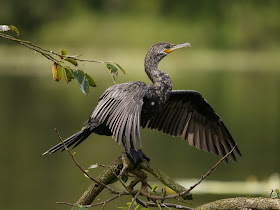Later we heard from others that they often go around in groups, and that they hunt for fish along waterways. They fly up into trees, in groups. Still a puzzle.
Then we heard that they actually swim. What? Swimming crows? By asking more questions, we were finally told that crows were very similar to the "pico fino" which we had already determined to be an Anhinga.
That was the missing piece of the puzzle. By asking a few more questions we confirmed that the cuervo (crow) was the Neotropic Cormorant.
So, how did a cormorant become a crow? If all you knew about crows were that they were big and black and fly around in groups (think Hitchcock), you could easily see how these birds could become crows. Especially when you see them sitting together on a bare tree, with their necks hunched in. They do kind of look like grackles--with longish tails, all black. And grackles can stretch out those necks, so that comparison isn't even all that hard to see, from a certain point of view (see for instance here).
At any rate, another cautionary tale about inter-cultural communication. You can never assume that just because you are using the same word, that you are talking about the same thing. Even within the same culture. Follow up questions are key. Even now, I wouldn't be surprised to find out that there is even more to the story of the Chontal Crow, so be prepared for further story installments!
.jpg)
(photo: wikipedia)
A great example of cultural differences. Also speaks to non-Western taxonomies for knowing birds. I see it as related to your question on why there aren't more birders in Mexico: there are people clearly engaging with birds, they're just not "doing it" it the way that we do—e.g. with field guides and binoculars.
ReplyDeleteI love this, Rob. I find this all the time among Americans that know of crows and blackbirds, but since they've never heard of grackles, assume that the latter are counted among the former.
ReplyDeleteGreat stuff, this. But as to "cultural differences" and "non-western taxonomies," just consider the historical origin of the English word "cormorant," apparently descended from Latin "corvus marinus," sea crow.
ReplyDeletedo they still take eggs? i hope someone has talked them out of that habit/tradition...
ReplyDelete